Khajuraho Group of Monuments: Difference between revisions
khajuraho institute of hotel management & tourism |
meta>Paanduraam m →History: Corrected typo there -> their |
||
| Line 19: | Line 19: | ||
==History== | ==History== | ||
The city was the cultural capital of [[Chandela]] [[Rajput]]s, a Hindu dynasty that ruled this part of India from the 10th to the 12th centuries. Political capital of Chandelas was [[Kalinjar]]. The Khajuraho temples were built over a span of 200 years, from [[950]] to [[1150]]. The Chandela capital was moved to [[Mahoba]] after this time, but Khajuraho continued to flourish for some time. Khajuraho has no forts because the Chandel Kings never lived in | The city was the cultural capital of [[Chandela]] [[Rajput]]s, a Hindu dynasty that ruled this part of India from the 10th to the 12th centuries. Political capital of Chandelas was [[Kalinjar]]. The Khajuraho temples were built over a span of 200 years, from [[950]] to [[1150]]. The Chandela capital was moved to [[Mahoba]] after this time, but Khajuraho continued to flourish for some time. Khajuraho has no forts because the Chandel Kings never lived in their cultural capital. | ||
The whole area was enclosed by a wall with eight gates, each flanked by two golden palm trees. There were originally over 80 Hindu temples, of which only 25 now stand in a reasonable state of preservation, scattered over an area of about 8 square miles (21 km²). | The whole area was enclosed by a wall with eight gates, each flanked by two golden palm trees. There were originally over 80 Hindu temples, of which only 25 now stand in a reasonable state of preservation, scattered over an area of about 8 square miles (21 km²). | ||
Revision as of 11:18, 2 February 2009
| UNESCO World Heritage Site | |
|---|---|
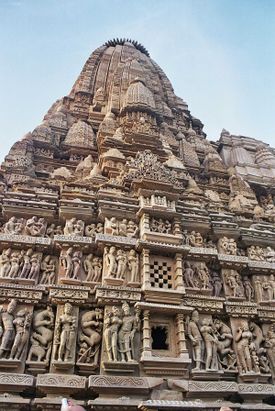 | |
| Criteria | Cultural: i, iii |
| Reference | 240 |
| Inscription | 1986 (10th session) |
Khajuraho (Template:Lang-hi) is a village in the Indian state of Madhya Pradesh, located in Chhatarpur District, about 385 miles (620 kilometres) southeast of Delhi, the capital city of India.
The Khajuraho group of monuments has been listed as a UNESCO World Heritage Site.
One of the most popular tourist destinations in India, Khajuraho has the largest group of medieval Hindu and Jain temples, famous for their erotic sculpture. The name Khajuraho, ancient "Kharjuravahaka", is derived from the Sanskrit word kharjur meaning date palm.
History
The city was the cultural capital of Chandela Rajputs, a Hindu dynasty that ruled this part of India from the 10th to the 12th centuries. Political capital of Chandelas was Kalinjar. The Khajuraho temples were built over a span of 200 years, from 950 to 1150. The Chandela capital was moved to Mahoba after this time, but Khajuraho continued to flourish for some time. Khajuraho has no forts because the Chandel Kings never lived in their cultural capital.
The whole area was enclosed by a wall with eight gates, each flanked by two golden palm trees. There were originally over 80 Hindu temples, of which only 25 now stand in a reasonable state of preservation, scattered over an area of about 8 square miles (21 km²).
The temples of Khajuraho suffered destruction by early Muslim invaders between c. 1100-1400 AD as various disfigured statues at the temple complex attest. Today, the temples serve as fine examples of Indian architectural styles that have gained popularity due to their explicit depiction of the traditional way of sexual life during medieval times. Locals living in the Khajuraho village always knew about and kept up the temples as best as they could. They were pointed out to an English man in late 19th century and the jungles had taken a toll on all of the monuments.
Geography
Khajuraho is located at Lua error: callParserFunction: function "#coordinates" was not found..[1] It has an average elevation of 283 metres (928 feet).
Demographics
Template:Infobox Indian Jurisdiction
As of 2001[update] India census,[2] Khajuraho had a population of 19,282. Males constitute 52% of the population and females 48%. Khajuraho has an average literacy rate of 53%, lower than the national average of 59.5%: male literacy is 62%, and female literacy is 43%. In Khajuraho, 19% of the population is under 6 years of age.
Architecture
The Khajuraho temples, constructed with spiral superstructures, adhere to a northern Indian shikhara temple style and often to a Panchayatana plan or layout. A few of the temples are dedicated to the Jain pantheon and the rest to Hindu deities - to God's Trio, Brahma, Vishnu and Shiva, and various Devi forms, such as the Devi Jagadambi temple. A Panchayatana temple had four subordinate shrines on four corners and the main shrine in the center of the podium, which comprises their base. The temples are grouped into three geographical divisions: western, eastern and southern.
With a graded rise secondary shikharas (spires) cluster to create an appropriate base for the main shikhara over the sanctum. Kandariya Mahadeva, one of the most accomplished temples of the Western group, comprises eighty-four shikharas, the main being 116 feet from the ground level.
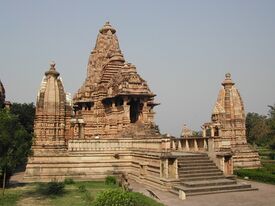
These shikharas – subordinate and main – attribute to the Khajuraho temples their unique splendor and special character. With a graded rise of these shikharas from over the ardhamandapa, porch, to mandapa, assembly hall, mahamandapa, principal assembly hall, antarala, vestibule, and garbhagriha, sanctum sanctorum, the Khajuraho temples attain the form and glory of gradually rising Himalayan peaks. These temples of Khajuraho have sculptures that look very realistic and are studied even today.
The Saraswathi temple on the campus of Birla Institute of Technology and Science, Pilani, India is modeled after the Khajuraho temple.
Chronology
The temples have been assigned the following historical sequence by Dr. Kanhaiyalal Agrawal.[3]
| Sequence | Modern name | Original Deity | Note |
| 1 | Chausath Yogini | 64 Yoginis | Est 9th c. |
| 2 | Brahma | Vishnu | Eastern group |
| 3 | Lalgun Mahadev | Shiva | Contemp to 2 |
| 4 | Matangeshwar | Siva | In active worship |
| 5 | Varaha | Varaha | |
| 6 | Lakshman | Vaikuntha Vishnu | Lakshavarma Inscription |
| 7 | Parshvanath | Adinath | Pahil inscription 954 AD, Jain Compound |
| 8 | Vishvanath | Shiva | Dhanga inscription Sam 1059 |
| 9 | Devi Jagadambi | Initially Vishnu but today Parvati | |
| 10 | Chitragupta | Surya | |
| 11 | Kandariya Mahadeva | Shiva | Largest |
| 12 | Vamana | Vamana | Eastern Group |
| 13 | Adinath | Jina | Jain compound |
| 14 | Jawari | Vishnu | Eastern group |
| 15 | Chaturbhuja | Vishnu | Southern |
| 16 | Duladev | Shiva | South end |
| 17 | Ghantai | Jina | Only some columns remaining |
Landscape
The Khajuraho temples are now set in a parkland landscape. When India gained independence from Britain in 1947 the landscape setting was semi-desert and scrub. The archaeological park now has something of the character of an English public park, with mown grass, rose beds and ornamental trees. This may be popular with visitors but has no relationship with the historic landscape at the time the temples were built.
The development of landscape archaeology as an academic discipline raises questions concerning the earlier landscape of Khajuraho and the original relationship between the temple complex and the surrounding area. There are no records of what the original landscape might have been, but it is known that a large community of priests used the temple complex and that Indian gardens in the tenth century were predominantly tree gardens. They did not have lawns or herbaceous flowering plants.
The statues and carvings of Khajuraho
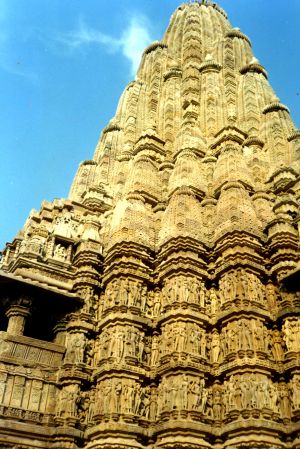
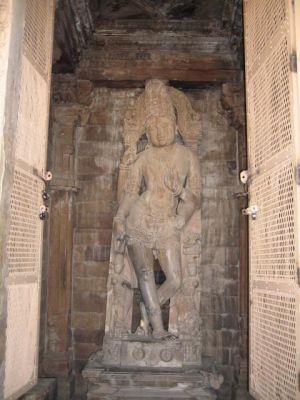
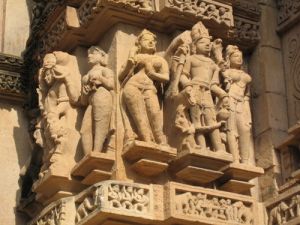
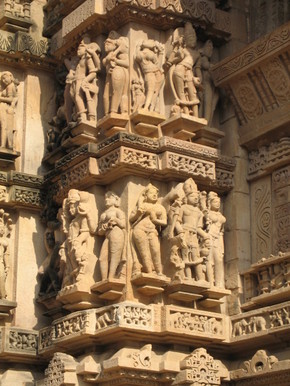
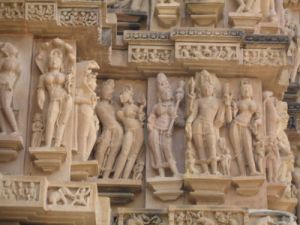
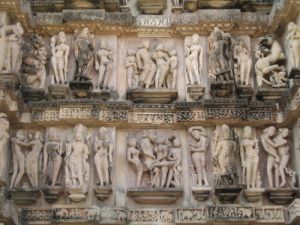
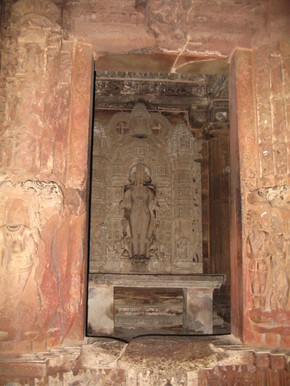
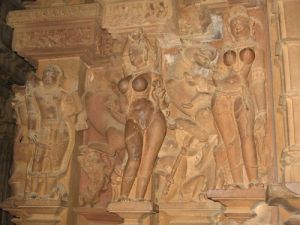
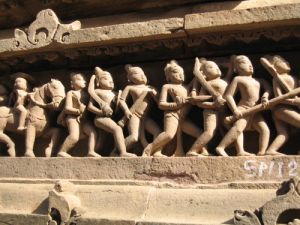
The Khajuraho temples do not contain sexual or erotic art inside the temple or near the deities; however, some external carvings bear erotic art. Also, some of the temples that have two layers of walls have small erotic carvings on the outside of the inner wall. There are many interpretations of the erotic carvings. They portray that, for seeing the deity, one must leave his or her sexual desires outside the temple. They also show that divinity, such as the deities of the temples, is pure like the atman, which is not affected by sexual desires and other characteristics of the physical body. It has been suggested that these suggest tantric sexual practices. Meanwhile, the external curvature and carvings of the temples depict humans, human bodies, and the changes that occur in human bodies, as well as facts of life. Some 10% of the carvings contain sexual themes; those reportedly do not show deities, they show sexual activities between people. The rest depict the everyday life of the common Indian of the time when the carvings were made, and of various activities of other beings. For example, those depictions show women putting on makeup, musicians, potters, farmers, and other folks. Those mundane scenes are all at some distance from the temple deities. A common misconception is that, since the old structures with carvings in Khajuraho are temples, the carvings depict sex between deities.[4]
Another perspective of these carvings is presented by James McConnachie. In his history of the Kamasutra, McConnachie describes the zesty 10% of the Khajuraho sculpture as "the apogee of erotic art": "Twisting, broad-hipped and high breasted nymphs display their generously contoured and bejewelled bodies on exquisitely worked exterior wall panels. These fleshy apsaras run riot across the surface of the stone, putting on make-up, washing their hair, playing games, dancing, and endlessly knotting and unknotting their girdles....Beside the heavenly nymphs are serried ranks of griffins, guardian deities and, most notoriously, extravagantly interlocked maithunas, or lovemaking couples."
While the sexual nature of these carvings have caused the site to be referred to as the Kamasutra temple, they do not illustrate the meticulously described positions. Neither do they express the philosophy of Vatsyayana's famous sutra. As "a strange union of Tantrism and fertility motifs, with a heavy dose of magic" they belie a document which focuses on pleasure rather than procreation. That is, fertility is moot.
The strategically placed sculptures are "symbolical-magical diagrams, or yantras" designed to appease malevolent spirits. This alamkara (ornamentation) expresses sophisticated artistic transcendence over the natural; sexual images imply a virile, thus powerful, ruler.[5]
Between 950 and 1050, the Chandela monarchs built these temples when the Tantric tradition may have been accepted. In olden days, before the Mughal conquests, when boys lived in hermitages, following brahmacharya until they became men, they could learn about the world and prepare themselves to become householders through examining these sculptures and the worldly desires they depicted.
Tourism
Khajuraho temple complex offers a well made light and sound show every evening. The first show is in English language and the second one in Hindi. The show is about an hour long and covers the history, philosophy and the art of sculpting of these temples. It is held in th e open lawns in the temple complex.
Recent Discovery
Archaeological Survey of India has recently started dig on a mound where perhaps the largest underground temple in Khajuraho has been unearthed. The dig will take at least a couple of years to conclude.
See also
References
- ↑ Falling Rain Genomics, Inc - Khajuraho
- ↑ Template:GR
- ↑ Khajuraho, Kanhaiyalal Agrawal, Macmillan India, 1980 (in Hindi)
- ↑ "Khajuraho", liveindia.com
- ↑ McConnachie, James (2005). The Book of Love, the Story of the Kamasutra. Metropolitan Press. pp. 46–47.
Further reading
- Phani Kant Mishra, Khajuraho: With Latest Discoveries, Sundeep Prakashan (2001) ISBN 8175741015
- Devangana Desai, The Religious Imagery of Khajuraho, Franco-Indian Research P. Ltd. (1996) ISBN 81-900184-1-8
- Devangana Desai, Khajuraho, Oxford University Press Paperback (Sixth impression 2005) ISBN-13: 978-0-19-565643-5
External links
- UNESCO World Heritage Site listing
- Khajuraho Temple Sculpture and Carvings Research Project & Photo Exhibition
- Photos about Khajuraho in the website of Italian writer Manuel Olivares
- Gallery of Khajuraho photos
- 100 photos 1280x960 of Khajuraho
- Template:Wikitravel
- Beauty of Khajuraho Temples
- Photos of the Khajuraho temple complex
bn:খাজুরাহ cs:Khadžuráho de:Khajuraho es:Khajuraho eo:Khaĝuraho fr:Khajurâho hi:खजुराहो bpy:খাজুরাহ it:Khajuraho kn:ಖಜುರಾಹೊ ka:ქაჯურაჰო ml:ഖജുരാഹോ mr:खजुराहो nl:Khajuraho new:खजुराहो ja:カジュラーホー pl:Khajuraho pt:Conjunto de Templos de Khajuraho ru:Кхаджурахо fi:Khajuraho sv:Khajuraho te:ఖజురహో వద్ద నిర్మాణ సమూహాలు vi:Khajuraho zh:克久拉霍古跡群 The Institute:A 20 years old organization has established
KHAJURAHO INSTITUTE OF HOTEL MANAGEMENT & TOURISM
at the world famous tourist place & temple city KHAJURAHO
to provide the professional education & generate the employment
Opportunities in the field of Hotel, tourism & in Service sector.
This institute is totally managed by Govt.Approved organization
Rastriya Bal Vikas Samiti,India(ESTD: 1990). The institute is
committed to provide 100% to each & every Students. For better
training & placement of students in India & Abroad institute is
associated with world leading chain hotels, travel agencies,
multinational companies. Fees of our institute is lowest among all
institutes in India. We provide a unique environment for learning.
The Institute is proud to accommodate students of different parts
of India. This multi-cultural environment gives students a unique
opportunity to experience different cultures. Students regularly
organize cultural events with food festivals to match every occasion.
The Institute has a team of dedicated curriculum experts who provide
the focus for academic developments and who are responsible for
innovations in response to the demands for industry and changing
requirement in education. The Institute does not hesitate to provide
learning facilities for students who may require special or additional
resources to help them with their studies, assignments and projects.
The Hotel Industry: The hotel & tourism industry is now world’s
second Largest industry, According to the survey this industry will
be No.1 industry of the world. Twenty five years ago, there were 186
approved hotels in the country, while today there are over 1000, which
means the growth rate of this industry is higher than any other. As the
industry is still in its expansion phase, it has a huge employment capacity.
The current demand of this industry is over 30,000, yet the collective
institutes train merely 6,000.
About Khajuraho: Khajuraho is the world famous tourist place &
is known for temples.
Location: In Madhya Pradesh
Significance: Well known for its temples.
Climate: Khajuraho has extreme tropical
climate with temperature as high as 40°C
in summers and as low as 4°C in winters.
By Air: Khajuraho has daily domestic flights to and from Delhi
Agra, Varanasi and Kathmandu, Kolkata etc
By Train: Khajuraho has railway station.
By Road:Khajuraho has frequent bus services and good roads
to and from the major cities of India like Delhi,Kanpur,Banda,Panna,
Mahoba,Satna,Jabalpur, Bhopal, Gwalior, Indore, Agra and Jhansi.
Temple town of Khajuraho is much different from any other temple city of
India. It is not about religion and worshipping and deities. The temples of
Khajuraho are instead famousfor the eroticism etched on its walls in the
form of sculptures. An amalgamation of science and art of architecture,
these 10th-11th century temples have a very interesting legend behind
them that connects them to the origin of Chandela dynasty. It is said that
in a fit of passion , the Moon God seduced and ravaged a beautiful
Brahmin girls known as Hemvati,resulting in the birth of Chandravarman
(the founder of the Chandela dynasty). Later, Chandravarman had a dream
where his mother requested him to make a temple, which would reveal all
aspects of the treasure of passion and erotic fantasy to the world. Thus he
brought an artistic revolution by building the famous Khajuraho temples,
in the town, which was his capital. It quickly became India's second most
favored tourist destination after Taj Mahal. This temple omplex is perhaps
the largest group of medieval temples. Other than eroticism, these sculptures
also depict other refined courtly accomplishments such as music and dance.
Only 22 temples have survived out of the original 85 temples. It displays one
of the most unique stone-carving work and was declared a World Heritage
Site in 1986.
Temples of Khajuraho:
It took more than 200 years to complete elaborately carved Khajuraho
temples that are planned in a similar pattern. Built in the central Indian
temple architectural style, the uninhibited and graceful erotic sculptures
of Khajuraho temples are known for their paramount architectural balance
and exquisiteness. The temple plans range from the simple ones to the
most inspired ones. The lovely temples can be divided into three broad
groups, namely, the Eastern group, the Southern group and the Western
group.
Kandariya Mahadeva Temple, Khajuraho
Vishvanath Temple, Khajuraho
Eastern Group of Temples, Khajuraho
Chitragupta Temple, Khajuraho
Chausath Yogini Temple, Khajuraho
Southern Group of Temples, Khajuraho
Lakshmana Temple, Khajuraho
The Western Group.
There are 8 five star & so many star hotels in Khajuraho:
Hotel Chandela ( Taj Group ) , Khajuraho
Hotel Usha Bundela Khajuraho
Ramada Hotel, Khajuraho
The Lalit Temple View, Khajuraho
Kairali Ayurvedic Resort , Khajuraho
Grand Temple View, Khajuraho
Hotel Clarks, Khajuraho
Hotel Greenwood Khajuraho , Khajuraho
Radisson Hotel, Khajuraho
CAMPUS: Jain Temple Road,Khajuraho (M.P.)
CONTACT: 09755127632,09235705975
E-MAIL: [email protected]
- Pages using infobox UNESCO World Heritage Site with unknown parameters
- Articles containing potentially dated statements from 2001
- Articles with invalid date parameter in template
- All articles containing potentially dated statements
- Pages with broken file links
- Commons category link is locally defined
- Cities and towns in Madhya Pradesh
- Hindu holy cities
- Bundelkhand
- Tourism in Madhya Pradesh
- Chhatarpur